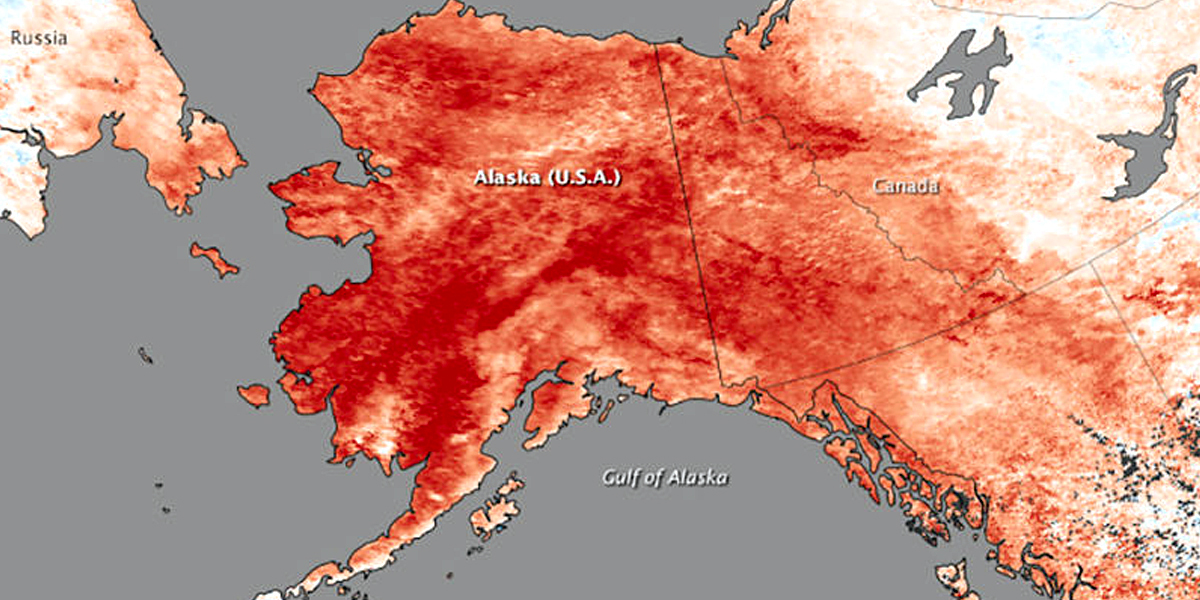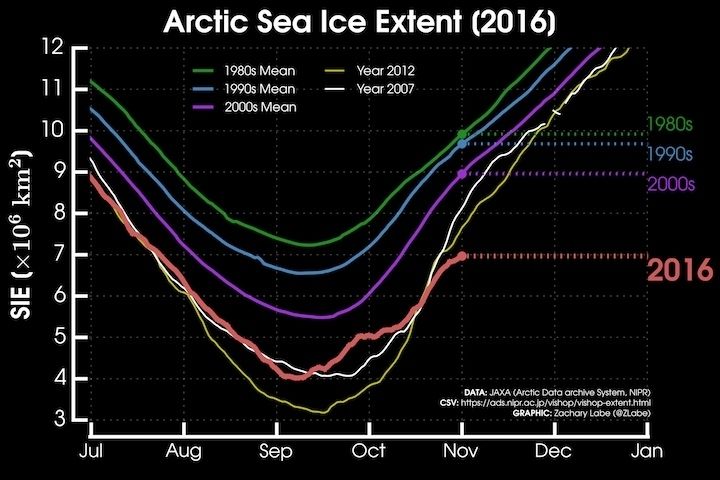
Alaska Sees ‘Astounding’ Rise in Temperature as ‘Drill, Baby, Drill’ Planned for Arctic

As 2016 is set to be the warmest year on record, Alaskans are seeing an “astounding” rise in temperature. Throughout October, average temperatures in Alaska ran 6.7 degrees above normal.
Alaska Village Votes to Relocate Due to Rising Sea Levels – EcoWatch https://t.co/dMxmJHjw2w @ukycc @EUClimateAction
— EcoWatch (@EcoWatch) August 19, 2016
Barrow, the northernmost community in the U.S., set its warmest October on record. Its monthly average came in at 30.1 degrees Fahrenheit, an astonishing 12.9 degrees warmer than the 1981-2010 average. Oct. 10 was the warmest October day ever, with a high of 44.
Every October since 2001, Barrow has been warmer than normal. Three other Alaskan coastal communities—Nome, St. Paul and Kotzebue—all set monthly records this October. Oct. 12 was the warmest October day ever in Nome by far—20 degrees above the previous record.
Alaska Heat Wave Shatters Records Bringing Warmest Temperature Ever to Deadhorse – EcoWatch https://t.co/7lgeTeco7K @Climate_Rescue @ukycc
— EcoWatch (@EcoWatch) July 16, 2016
The Arctic is warming twice as fast as the rest of the world. This year, the sea ice tied for its second-lowest extent after a record-early spring melt set in. And it’s having a lot of trouble reforming for the winter.

In October, the sea ice covered 2.5 million square miles, the lowest October ever seen. It remains low in the Beaufort, Chukchi, East Siberian and Kara Seas, where water temperatures were above normal. It’s the slowest regrowth of Arctic sea ice on record.
Older, thicker ice is disappearing. As more sea ice melts each summer, the ice that reforms in winter is new, thinner ice.
“The older ice is becoming weaker because there is less of it, and the remaining ice is more broken up and thinner,” said Walt Meier, a sea ice researcher at NASA’s Goddard Space Flight Center. Thirty years ago, old ice comprised 20 percent of the sea ice cover; today it is just three percent.
https://www.youtube.com/watch?v=6ZAuRpK4tkc
There is a direct link between global carbon emissions and the loss of Arctic sea ice. For every metric ton of CO2 put into the atmosphere, 30 square feet of sea ice is lost. That’s the conclusion of researchers Dick Notz and Julienne Stroeve in a landmark study published last week.
With new oil discoveries in Alaska and a fossil-fuel friendly president about to enter the White House, the future looks even darker.
Noam Chomsky: 'The Republican Party Has Become the Most Dangerous Organization in World History' https://t.co/zIDnmTHkZd @MichaelEMann @350
— EcoWatch (@EcoWatch) November 14, 2016
Here are seven key concerns when it comes to drilling in the Arctic:
1. Smith Bay: Caelus Energy announced what it called a “world-class” find in Smith Bay that could prove to be one of the largest oil fields in Alaska. The site, just 50 miles from Barrow, could produce 200,000 barrels per day of light, highly mobile oil, the company said.
2: Moose Pad: Hillcorp Alaska is set to drill up to 44 wells in an area 25 miles from Prudhoe Bay. The company expects to begin drilling in 2018.
3. Liberty Field: Another Hillcorp site in the North Slope, this one on the outer continental shelf, could add up to 70,000 barrels of oil per day to the 40-year old trans-Alaska pipeline.
4. North Slope and Beaufort Sea: Alaska is conducting a lease sale now on state-owned land on the North Slope and state-owned waters of the Beaufort Sea.
5. Beaufort and Chukchi Seas: Alaska Gov. Bill Walker has asked the U.S. Department of the Interior to include the two Arctic seas in the federal offshore leasing program. These include areas where Shell drilled in 2015.
6. Fiord West: Last month, ConocoPhillips ordered a monster new drilling rig that can radiate outward to reach oil within 125 square miles from a single site. It will use the rig to develop the Fiord West field on the North Slope.
7. Arctic National Wildlife Refuge: A political battleground for decades, with the control of the federal government now squarely in Republican hands, “pro-development Alaskans could already taste oil,” wrote Alaska Dispatch News following the election. Alaska Sen. Lisa Murkowski, who chairs the energy committee, said that she “is a champion of access to federal lands and waters.”

 233k
233k  41k
41k  Subscribe
Subscribe 